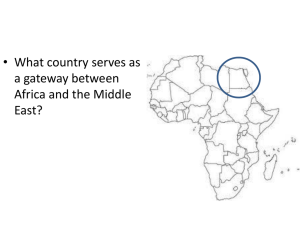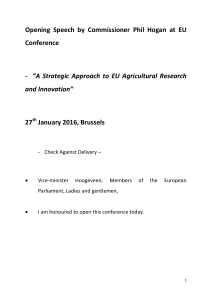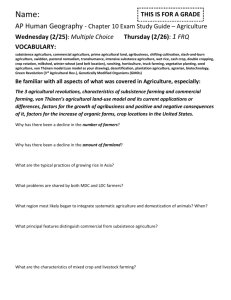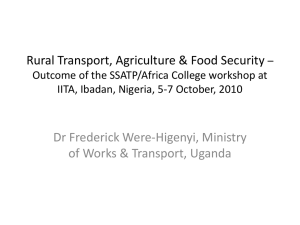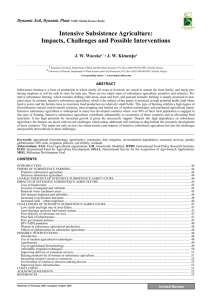Online Discussion on Examining the linkages between trade and food
advertisement
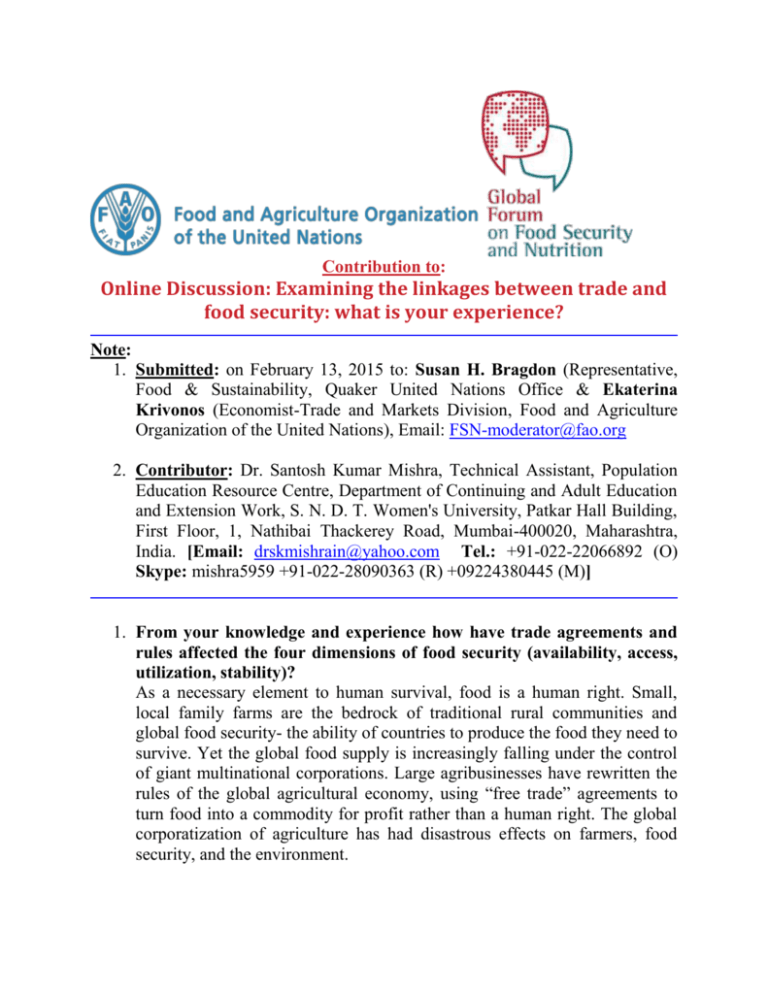
Contribution to: Online Discussion: Examining the linkages between trade and food security: what is your experience? Note: 1. Submitted: on February 13, 2015 to: Susan H. Bragdon (Representative, Food & Sustainability, Quaker United Nations Office & Ekaterina Krivonos (Economist-Trade and Markets Division, Food and Agriculture Organization of the United Nations), Email: FSN-moderator@fao.org 2. Contributor: Dr. Santosh Kumar Mishra, Technical Assistant, Population Education Resource Centre, Department of Continuing and Adult Education and Extension Work, S. N. D. T. Women's University, Patkar Hall Building, First Floor, 1, Nathibai Thackerey Road, Mumbai-400020, Maharashtra, India. [Email: drskmishrain@yahoo.com Tel.: +91-022-22066892 (O) Skype: mishra5959 +91-022-28090363 (R) +09224380445 (M)] 1. From your knowledge and experience how have trade agreements and rules affected the four dimensions of food security (availability, access, utilization, stability)? As a necessary element to human survival, food is a human right. Small, local family farms are the bedrock of traditional rural communities and global food security- the ability of countries to produce the food they need to survive. Yet the global food supply is increasingly falling under the control of giant multinational corporations. Large agribusinesses have rewritten the rules of the global agricultural economy, using “free trade” agreements to turn food into a commodity for profit rather than a human right. The global corporatization of agriculture has had disastrous effects on farmers, food security, and the environment. Global agricultural policy used to be geared towards maintaining stability in global markets. Supply management programs, also called commodities agreements, helped maintain production around the same as demand, so that farmers didn’t produce an oversupply that would cause prices to collapse. These programs helped keep market prices above a price floor, which is a minimum price over the cost of production that farmers need to survive. In addition, countries have historically promoted their local economies by protecting domestic production from foreign competition. Most countries maintain taxes on foreign imports, called tariffs, as well as outright limits on the quantities of foreign imports, called quotas, in order to favor local economic development. This has especially been true in the agricultural sector, where local food production is key to food sovereignty. Feeding the world in 2050 when our global population is expected to reach over 9 billion is one of the most daunting challenges of our time. In the face of climate change, and with scarce land and water resources, we must rapidly address this challenge and lay in place the right frameworks to boost food production and freeze the environmental footprint of agriculture all along the food value chain. We must also unlock the potential of millions of small producers who could be part of the solution to feed the planet. Trade is an integral aspect of increased productivity and food security. All farmers, regardless of size, will only produce more when they see an available market. These decisions are no longer as local as they once were. With agricultural value chains becoming more complex, actions taken in far off capitals – and regional and international institutions as well – will have an impact on the rural small farmer more than ever before. The laws and regulations governing the different aspects of value chain development, many of which are part of trade agreements and institutions, also directly tie into market opportunity and productivity. The potential gains associated with increased trade and easier movement of goods and services are becoming increasingly clear. Trade has now become a significant component of food security efforts and the broader agricultural development agenda. A strong enabling environment – with transparent and well-implemented laws, regulations, and trade policy – is central to value chain development. One of the biggest challenges in creating this enabling environment will be closing the gap between the system on the books and the realities in the market. This applies to domestic and regional laws and 2 regulations, implementation of trade agreements, and transparent regulatory systems alike. There are positive developments taking place at the intersection of trade, agriculture, and food security. But trade needs to be further integrated and better used as a tool for market development and productivity enhancement. In order to open markets effectively and to the benefit of all, innovation from both the public and private sectors will be increasingly important. Overall, the 21st century will require a trade policy that is forward-looking and innovative in order to take advantage of future market opportunities. Trade can and should impact individuals positively, add value economywide, and deliver broader food security and development benefits. The new vision for agriculture should focuses on three strategic areas: Facilitating leadership commitment to action by facilitating dialogue, commitment building and collaboration among diverse stakeholders; Supporting country transformation by catalyzing and supporting action-oriented, multi-stakeholder partnerships at regional and country levels; and Promoting innovation and best practice by facilitating exchange of innovation, experiences and best practices among stakeholders and regions, and monitoring partnership impact to track progress. 2. What is your knowledge and experience with creating coherence between food security measures and trade rules? Can rights-based approaches play a role? Trade in agriculture is a vital part of international development. Ensuring that developing countries can have food security and benefit from international trade should be a priority for developed and developing countries alike. The right to food is a fundamental human right. Global commitments to make food security a reality for all people recognize that fair rules for international trade within a multilateral trade system are essential to achieve this goal. In developing countries, on average almost 60% of people are involved in food production. Trading food at fair prices is essential for their short and long term development. The link between trade and food security becomes clear through an examination of the basic principles, specific policies, and implications of international agreements for people who cannot take food security for granted. Basic principles and 3 specific policies are both important in the debate about food security and trade liberalization: o First, the points of intersection between food security and the agreement should be clarified. o Second, the relationship between international commitments to food security and commitments to trade liberalization must be assessed in order to have coherence. o Third, ways to broaden the definition of food security and its application within trade agreements should be explored. Agricultural production is about our human need for food, not simply about markets. It is true that not all regions of the world can or should attempt to be competitive in the area of agriculture exports. Households and countries may be able to rely on the international supply of food to satisfy their needs, but only if the rules for trade are fair and give priority to the need for food security. In short, developed and developing countries must work together to ensure that more liberalized trade agreements are compatible with food security. 3. How can a food security strategy, including components that explicitly support small-scale farmers in agro-biodiverse settings, be implemented in ways that might be compatible with a global market-based approach to food security? Food security is recognized world-wide as a fundamental dimension of national development, good governance and basic human rights. The generally accepted definition of food security is: “Food security exists when all people, at all times, have physical and economic access to sufficient, safe, and nutritious food, enabling them to meet their dietary needs and food preferences for an active and healthy life”. Food security is recognized as a basic human right under international law. However, the global food system today is beset by serious challenges and risks: o production and prices have become more volatile; o hunger and poverty levels remain high, particularly among farming communities; and o unsustainable practices exacerbate environmental challenges. By the year 2050, the world’s population will have risen to 9 billion. Feeding this population will require substantial changes to ensure the production, distribution and consumption of sufficient nutritious and 4 sustainably produced food. As the economy grows and markets develop for a variety of products, subsistence production is gradually replaced by production for the market. This tendency is further strengthened when an economy opens up to the outside world. If this happens at an advanced stage, when the population has already crossed the threshold of hunger, as has been the case in the Western world, the shift from subsistence food production to market production does not pose a serious problem to food security. In fact, it may even enrich the diet of the population by enabling it to obtain a wide variety of food from all over the world. But if market orientation occurs at an early stage, when a large section of the population has yet to secure access to sufficient food to guarantee a minimum required diet, questions are bound to arise regarding its impact on food security. Questions have indeed arisen in recent years in the context of the macroeconomic reforms currently sweeping the Developing World. Markets are opening up both internally and externally, thus providing incentives to farmers to shift towards cash crops. Structural adjustment programs are strengthening these incentives by making production for export more profitable than before. Partly as a result of these policy reforms and also because of increasing urbanization, agriculture can be expected to become increasingly diversified and commercialized in coming years. In order to gain further insight into the importance of subsistence income on the ‘down’ side, it is necessary to consider the forces that are responsible for reducing subsistence income. Two kinds of forces need to be distinguished here. They may be referred to as ‘push’ forces and ‘pull’ forces. Pull forces are those that divert household resources from subsistence production to potentially more attractive market-oriented activities. Push forces operate when the loss of resources (such as land, labour and capital) compel households to cut down on subsistence activities. These two forces must be distinguished because the loss of subsistence income is arguably more likely to entail losses in food security when it is caused by push forces rather than by pull forces. Most importantly, pro-poor transformation of rural economies requires increasing agricultural productivity and efficiency along value chains, diversifying economic activity, and integrating the rural economy into the broader economy through sound market systems. And for the rural and urban poor alike food security is rooted in sufficient, sustainable income. Through value chain and market system analysis, it is possible to: 5 a) identify constraints in agricultural markets, including input and output markets; and b) develop solutions that change the structure of incentives so that market interactions benefit the poor. Academic Profile of Contributor Dr. Santosh Kumar Mishra I am researcher & demographer employed (since August 1987) with the Population Education Resource Centre (PERC), Department of Continuing and Adult Education and Extension Work, S. N. D. T. Women's University, (SNDTWU, http://sndt.ac.in/) located at Mumbai in India. I underwent training in demography from the IIPS, Mumbai, India (http://www.iipsindia.org/) & acquired Ph. D. in 1999. Also, I completed Diploma in Adult and Continuing Education & HRD, and Certificate Course in Hospital & Health Care Management. My subject areas of interest / research include: population & development education, issues pertaining to population-development linkages, education for sustainable development, adult & continuing education/non-formal/extension education, etc. Responsibility at the PERC, SNDTWU is assistance in: (a) research studies, (b) training/ orientation for various levels of personnel, (c) curriculum development, (d) material production / publication, (e) monitoring/ evaluation, and (f) other extension program on population education & allied subjects. My work experience includes: helping PERC in research studies, material preparation, data collection, documentation & dissemination, preparing reports, organizing training/orientation programs/workshops, monitoring & evaluation of population education programs, and curriculum design; publications (articles, technical papers, etc.); contribution of papers in national and international seminars/ conferences; documentation and dissemination of population information; 6 review of papers for national and international journals (in the capacity of reviewer / editor); review of conference sessions; preparation of educational materials (print version) for other organizations, assistance in preparing evaluation tool; (h) assistance in evaluation of Ph. D. theses, dissertations & projects reports; editing and proofreading of book, book chapters, etc.; & mentoring students in their studies & counseling students & parents in career planning matters during informal interactions – both at workplace and outside. I am Reviewer/Editorial Board Member for over 40 international journals. I have also reviewed papers for 7 international conference sessions, including EURAM 2014 Conference (4-7 June 2014, University of Valencia, http://site.aace.org). I have authored (some co-authored) 5 research studies (published by SNDTWU); 32 papers for national conferences & 11 papers for international conferences; 5 handbooks/booklets (published by the SNDTWU); 5 books, & 11 book chapters. In addition, I have 32 articles published in national journals and 22 in international journals, besides 2 monographs. I was awarded Government of India fellowship at the IIPS & travel scholarship for sharing my research views at international conferences and summits held in: o Pakistan, o Tanzania, o Sweden, o USA, o Tajikistan, o Australia, & o Philippines. I am Advisory Board Member of the American Academic & Scholarly Research Center (http://aasrc.org/?page_id=38) and Reviewer-cum-International Advisory Board Member for the AASRC 2013 International Conference-Beirut, Lebanon (http://aasrc.org/conference/? page_id=803). I can be reached at: Email: drskmishrain@yahoo.com, Skype: mishra5959, & Tel.: +91-022-22066892 (O) +91-022-28090363 (R) +09224380445 (M). 7
